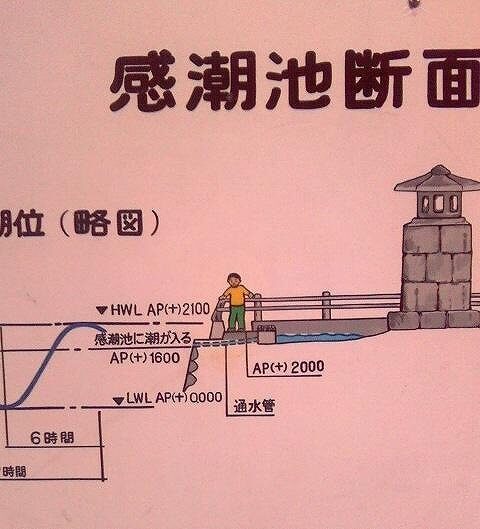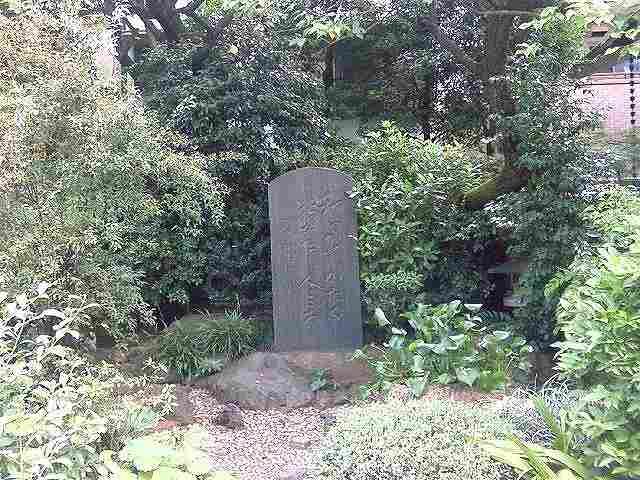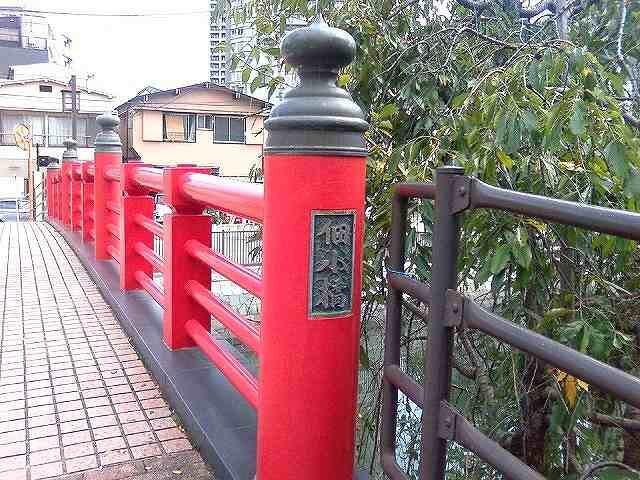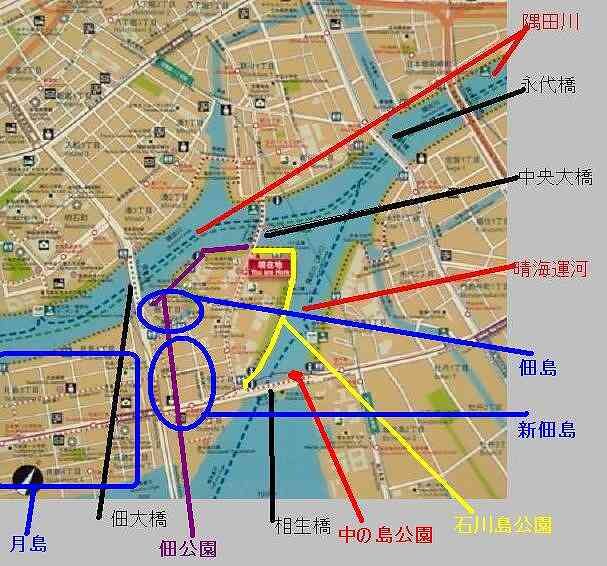Tsukuda Park is contiguous with Ishikawajima Park, and the Chuo Ohashi Bridge is the border between the two parks.
From the Chuo Ohashi Bridge upstream to the Tsukuda Ohashi Bridge downstream, Tsukuda Park is along the Sumida River, and from the Chuo Ohashi Bridge up the Sumida River, turn right toward the Harumi Canal and then turn right along the Sumida River and Harumi Canal to the Aioi Bridge, which is Ishikawajima Park.
Tsukuda Park has the monument “Green Wind”, a tile mural located under the Chuo Ohashi Bridge, the restored remains of the Ishikawajima Lighthouse, and the Tsukuda Hori, a space where downtown and high-rise buildings intersect.
 This stone is at the opposite end of the Central Bridge.
This stone is at the opposite end of the Central Bridge.
Tsukuda Island and Ishikawa Island at the end of the Edo period
In 1866 (Keio 2), Shimizu Junzaki, the Ishikawajima Yorojo Magistrate, had a lighthouse built at the southern end of the Yorojo for ships sailing in the Sumida estuary and off the coast of Shinagawa. The lighthouse is said to have been an imposing two-story, hexagonal lighthouse.
The Ishikawajima jinzoku yoriba was built in 1790 by Hasegawa Heizo Nobuyoshi, a fire-fighting bandit reformer, who applied to Matsudaira Sadanobu, an old man, and it is officially called “Kayaku jinzoku yoriba”.
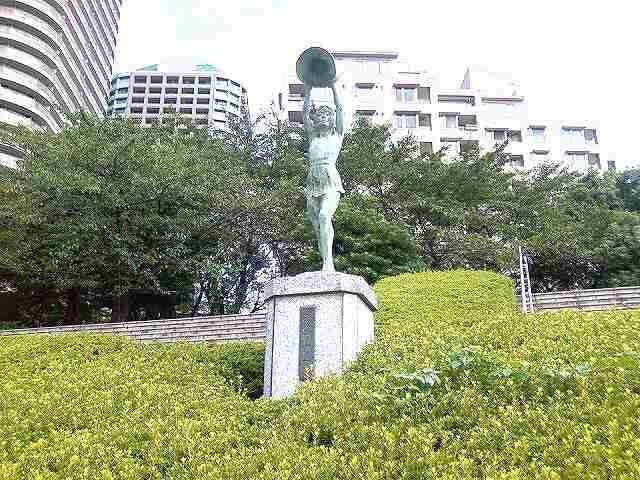
Midori-no-kaze is photographed from Sumida River. The ruins of Ishikawajima Lighthouse are on the right side of the upper right stairs.
In 1582, Ieyasu was told of the Honnoji Incident and headed for Osaka, but when he was at a loss due to the water outflow The village headman of Tsukuda Village sent out many boats to help the group.
Later, when Ieyasu established the shogunate in Edo, he encouraged the fishermen to go to the shogunate as a reward for their services, and they were given the privilege of fishing in the waters around Edo.
In 1644, a 100-meter square piece of land was reclaimed and built on the present site, and the island was named Tsukudo-jima after the shrine of Sumiyoshi Shrine in Settsu Province, his hometown.
Chuo City Peace City Declaration
Chuo City has declared itself a city of peace and has a monument in Tsukuda Park to show both inside and outside the city that it will contribute to lasting peace in the world by recognizing peace as the foundation of human prosperity and by reflecting the idea of peace in the city’s policies.

Let us pause for a moment
and look at the preciousness of peace
No matter how small the happiness
And all the joys of prosperity
If the light of peace is extinguished
All will be lost
Let us pass on this brightness in our hands to tomorrow’s generation
March 15th, 1988
On this day, we wish for everlasting peace
We proclaim that Chuo City is a city of peace.
Sumida River and Seine River
The Sumida River is a Friendship River with the Seine River in France.
This Friendship River was developed from the friendship relationship between Tokyo Metropolitan Government and Paris, the capital of France, which was established on July 14, 1982.
Tokyo has sister city relationships with 11 cities (states), including New York City (USA), Beijing (China), Paris (France), New South Wales (Australia), Seoul (Republic of Korea), Jakarta (Indonesia), Sao Paulo (Indonesia), São Paulo (Federative Republic of Brazil), Cairo (Arab Republic of Egypt), Moscow (Russian Federation), Berlin (Federal Republic of Germany), and Rome (Italian Republic).

Sumida River and Seine River Friendship Memorial Pillar.”

This is Tsukuda Park taken from Chuo Ohashi Bridge.
Tsukudukudajima Watership Monument
In July of 1962, there were 70 round trips between Tsukuda Island and the west end of the Tsukuda Bridge, but with the completion of the Tsukuda Bridge in August of 1964, the ferry was discontinued. In 1926 the Tsukudukushima ferry was transferred to the management of the city of Tokyo, and in March of the 2nd year of the Showa era, it became a non-paying tugboat ferry, and this monument was built at that time.
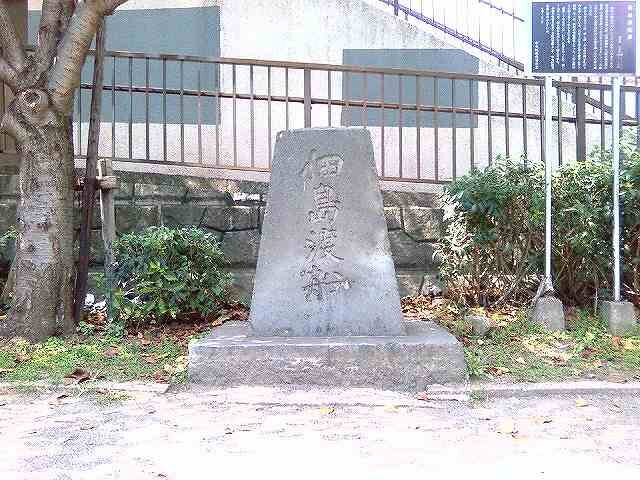
Tsukudo-shima Watership Monument
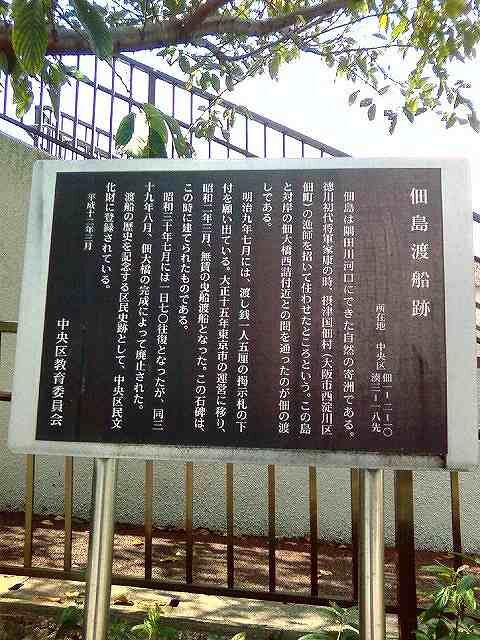
This information board explains the relationship between the Tokugawa family and the fishermen of Tsukuda Island, the origins of Tsukuda Island, and the lighthouse on Ishikawa Island.
Ruins of Tsukudukudajima ferry terminal
Ruins of Tsukudukudajima Ferry Terminal
Location: 1-2-10 Tsukuda, 3-18 Minato, Chuo-ku
Tsukudu-Dima is a natural sandbank that formed at the mouth of the Sumida River. It is said that when Ieyasu, the first Tokugawa shogun, invited fishermen from Tsukuda Village in Settsu Province (Nishiyodogawa Ward, Osaka City) to live here.
The Tsukuda ferry passed between the island and the west end of the Tsukuda Bridge on the other side of the river. In July of 1876, a request was made for a 5 rin per person ferry bill to be posted on the island.
In 1926, the ferry was transferred to the management of the city of Tokyo, and in March of 1927, it became a non-paying tugboat ferry.
This monument was erected at that time.
In July 1955, the number of round trips increased to 70 per day. In August 1939, with the completion of the Tsukuda Bridge, the number of round trips increased to 70 per day, and in March 2001, the number of round trips increased to 70 per day.
Chuo City Board of Education
Houjou Shuji Phrase Monument

Near the monument at the site of the Tsukudukushima ferry is a uniquely shaped twisted monument called the “Houjou Shuji Phrase Monument.
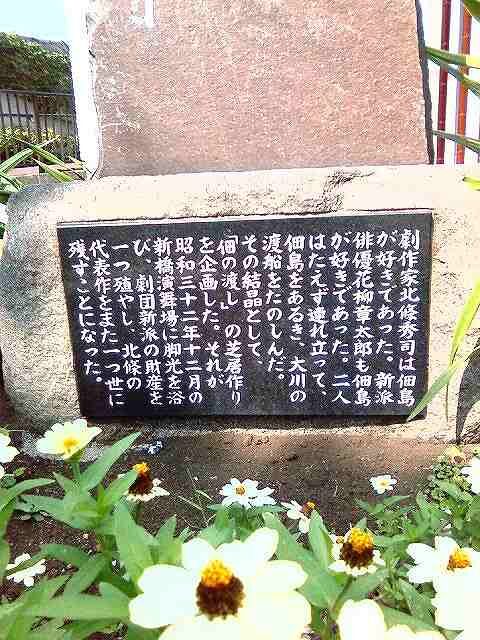
The playwright Houjou Shuji loved Tsukuda Island.
The new school actor Shotaro Hanayagi also loved Tsukuda Island.
The two of them always enjoyed walking around Tsukuda Island and taking the Okawa ferry together.
As a result, they planned to produce a play called “Tsukuda no Ferry.
The play was performed at the Shinbashi Enbujo Theatre in December 1957, and it was to be one more of Houjou Shuji’s masterpieces to be handed down to the world.
Ruins of Ishikawajima Lighthouse
The Ishikawajima Lighthouse was built in 1866 by Shimizu Junki, an official of the Ishikawajima Yoroi Yoriba, for ships navigating the mouth of the Sumida River and off the Shinagawa River. The current lighthouse is said to have been reproduced from Hiroshige’s Ukiyoe. The actual lighthouse was located on the opposite bank of the river from the Sumiyoshi Shrine water gate.
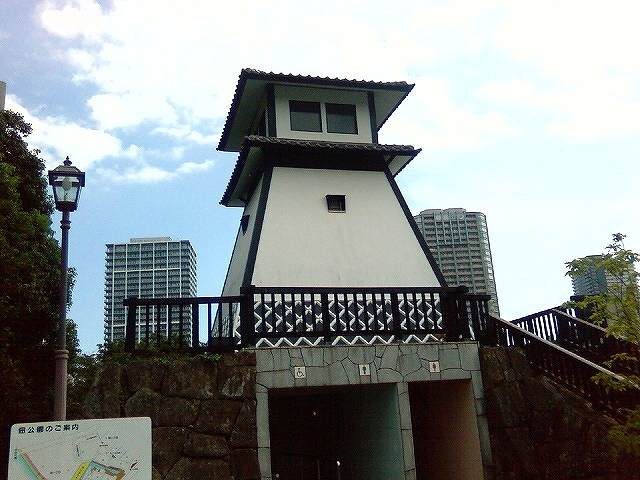
Underneath the ruins of the Ishikawajima Lighthouse is a toilet (laughs).

This information board explains the relationship between the Tokugawa family and the fishermen of Tsukuda Island, the origins of Tsukuda Island, and the lighthouse on Ishikawa Island.
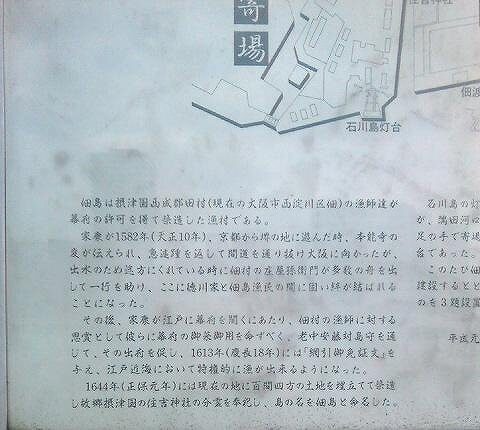
Tsukudukudajima was a fishing village built by fishermen from Tamura, Nishinari-gun, Settsu Province (present-day Tsukuda, Nishiyodogawa-ku, Osaka City) with permission from the shogunate.
When Ieyasu was in Sakai from Kyoto in 1582, the Honnoji Incident was reported, and he turned on his heel and headed for Osaka, but when he was at a loss because of the flood, Magoemon, the village headman of Tsukuda Village, sent out many boats to help the group.
Later, when Ieyasu established the Tokugawa shogunate in Edo, he ordered the fishermen of Tsukuda Village to serve the shogunate as a reward, and through his chief advisor Ando Tsushima, he encouraged them to come to the shogunate.
In 1644 (Shoho first year), he reclaimed a 100-meter square piece of land on the present site, dedicated it to the spirit of Sumiyoshi Shrine in his hometown in Settsu Province, and named the island Tsukudo-jima.
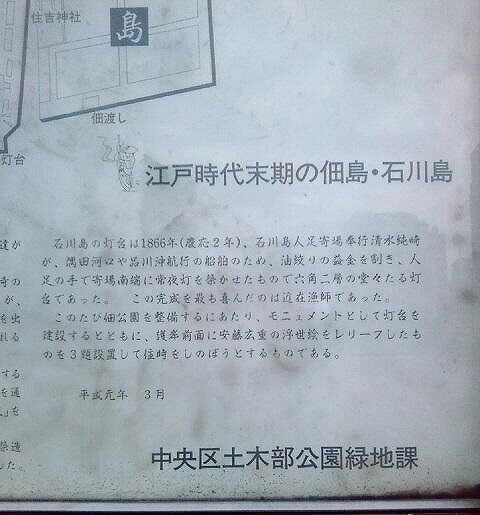
The lighthouse on Ishikawa Island was built in 1866 (Keio 2) by Shimizu Junzaki, the Ishikawajima Yorishiba Magistrate, who used the profits from oil drilling to build a nightlight at the southern end of the Yorishiba for ships sailing in the Sumida Estuary and off Shinagawa. The fishermen in the area were most pleased with the completion of the lighthouse.
When the Tsukuda Park was being developed, the lighthouse was built as a monument, and three ukiyoe reliefs by Hiroshige Ando were placed in front of the seawall to remind us of the old days.
March 1989
Parks and Greenery Division, Public Works Department, Chuo City

